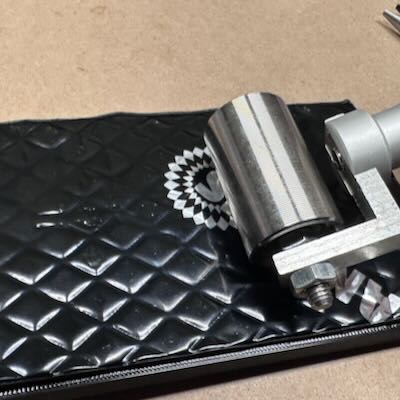Interesting Materials
I wanted to highlight some interesting materials that people may not know about. These can easily solve a lot of problems when building things.
Butyl-Mastic Sheets

Butyl rubber, or just butyl, is a synthetic rubber. There are a bunch of different versions, but there is a version that is is made as a blend with mastic which is available in sheets with adhesives and, typically, very thin aluminum outer layer. So what good is it? Well, it is very useful for dampening vibrations in cars (where you often see it added) and speakers. This is the same basic compound, in a different formulation, that can be used in some sealants.
For example, I printed a 3D enclosure for some small speakers for a project, and used butyl-mastic sheets to dampen the vibrations that the plastic would otherwise exhibit. As a side benefit, it's quite dense, so it adds a certain heft to the project.
Ultra-High Molecular Weight (UHMW) Polyethylene
A very neat plastic that has a similar coefficient of friction (think how slick something is) to PTFE (Teflon), but is substantially more abrasion resistance. It's available in sheets, rods, and especially useful in tape form.
3M VHB Tape
This is a situation where I'd call out a specific manufacturer's part. 3M has a deserved reputation for being the master of adhesives, and VHB tape is a great example of their skills. While not inexpensive (beware "cheap" partial rolls, they're almost always fake), the tape can pull off miracles of making 2 things stick together. The tape is strong enough that in some of its forms, it is used by automakers to hold things together. The design guide can help you figure out which would work for you.
Low Melt Alloys
Some Metals Can Be Toxic
Many of the low melt alloys, such as Wood's metal, can be very toxic. While lead is a bad enough metal to work with, the cadmium resent in Wood's metal, and others, is exceptionally toxic in even smaller dosages. If you are going to work with these metals:
- Work outside only. Do not hammer, melt, or otherwise manipulate the metal indoors without exceptionally good ventilation.
- Wear Gloves. Always. No exception. Good ones. I exclusively use Kimberly-Clark nitrile gloves (available at many retailers for a reasonable price). I can't find the reference, but they are 5 mil thick, which is a reasonably thick glove.
Low melt allows are mixtures of metals that have a melting point lower than any of the constituent metals. They're useful for low-temperature (as low as 47C) casting, and they are excellent for use in gravity casting, which is super simple.
Typically, the lowest-temperature alloys are composed of some combination of (in typical ratio/popularity):
- Bismuth
- Lead
- Tin
- Indium
- Cadmium
- Antimony
A lot of these also have colloquial names for them, such as Field's metal, Wood's metal, or Rose's metal. Personally, I avoid anything with cadmium.
A great source for these metals is Rotometals in San Leandro, CA. I've bought from them repeatedly, and service is excellent, they are responsive, and they ship quickly, even for small quantities.
Demonstrate Gravity Casting with PLA
Yes, PLA everyone's favorite lactic acid polymer that prints lovely in FFF printers. There are some eutectic alloys that melt low enough to potentially be cast into a PLA mould. PLA has a glass transition temperature of 60-65C, which means there are at least two alloys we could use: Roto117F, which is bismuth, cadmium, lead, tin, and indium, and Roto136F, which is bismuth, lead, tin, and indium.
Indium-Tin-Oxide (ITO) Glass
Indium-tin-oxide coated glass is a type of coated glass that is semi-conductive. It actually forms, in most of its forms, a N-type semiconductor. It has very high light transmittance and relatively low resistance (10-100Ω) per square cm. It can be either single or double sided application. This is used in many touch screen designs, some types of solar cells, and can also form a RF shield. One place you can buy it is Techinstro.
Comments or Questions?
If you have any comments, questions, or topics you'd like to see covered, please feel free to either reach out to me on Mastodon (link below) or open an issue on Github.